【最新】仁爱版八年级英语下册unit7 Topic2 sectionB教案设计
- 格式:doc
- 大小:192.00 KB
- 文档页数:8
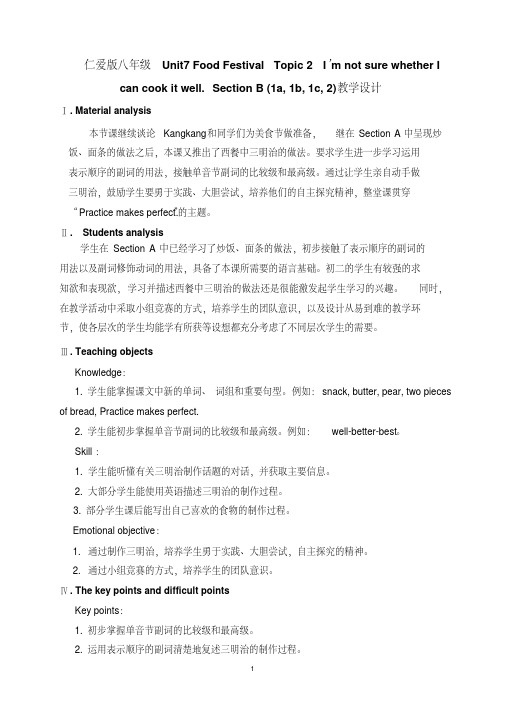
仁爱版八年级Unit7 Food Festival Topic 2 I’m not sure whether I can cook it well. Section B (1a, 1b, 1c, 2) 教学设计Ⅰ. Material analysis本节课继续谈论Kangkang和同学们为美食节做准备,继在Section A中呈现炒饭、面条的做法之后,本课又推出了西餐中三明治的做法。
要求学生进一步学习运用表示顺序的副词的用法,接触单音节副词的比较级和最高级。
通过让学生亲自动手做三明治,鼓励学生要勇于实践、大胆尝试,培养他们的自主探究精神,整堂课贯穿“Practice makes perfect.”的主题。
Ⅱ. Students analysis学生在Section A中已经学习了炒饭、面条的做法,初步接触了表示顺序的副词的用法以及副词修饰动词的用法,具备了本课所需要的语言基础。
初二的学生有较强的求知欲和表现欲,学习并描述西餐中三明治的做法还是很能激发起学生学习的兴趣。
同时,在教学活动中采取小组竞赛的方式,培养学生的团队意识,以及设计从易到难的教学环节,使各层次的学生均能学有所获等设想都充分考虑了不同层次学生的需要。
Ⅲ. Teaching objectsKnowledge:1. 学生能掌握课文中新的单词、词组和重要句型。
例如:snack, butter, pear, two pieces of bread, Practice makes perfect.2. 学生能初步掌握单音节副词的比较级和最高级。
例如:well-better-best。
Skill:1. 学生能听懂有关三明治制作话题的对话,并获取主要信息。
2. 大部分学生能使用英语描述三明治的制作过程。
3. 部分学生课后能写出自己喜欢的食物的制作过程。
Emotional objective:1.通过制作三明治,培养学生勇于实践、大胆尝试,自主探究的精神。
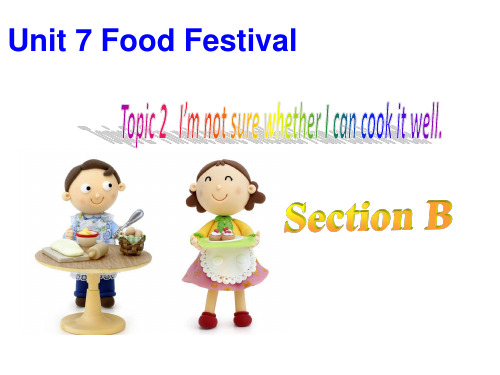

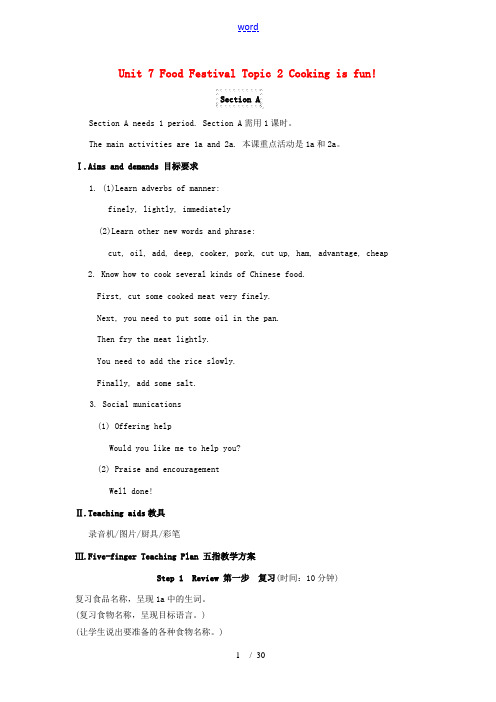
Unit 7 Food Festival Topic 2 Cooking is fun!Section ASection A needs 1 period. Section A需用1课时。
The main activities are 1a and 2a. 本课重点活动是1a和2a。
Ⅰ.Aims and demands 目标要求1. (1)Learn adverbs of manner:finely, lightly, immediately(2)Learn other new words and phrase:cut, oil, add, deep, cooker, pork, cut up, ham, advantage, cheap2. Know how to cook several kinds of Chinese food.First, cut some cooked meat very finely.Next, you need to put some oil in the pan.Then fry the meat lightly.You need to add the rice slowly.Finally, add some salt.3. Social munications(1) Offering helpWould you like me to help you?(2) Praise and encouragementWell done!Ⅱ.Teaching aids教具录音机/图片/厨具/彩笔Ⅲ.Five-finger Teaching Plan 五指教学方案Step 1 Review 第一步复习(时间:10分钟)复习食品名称,呈现1a中的生词。
(复习食物名称,呈现目标语言。
)(让学生说出要准备的各种食物名称。
)T: We’ll prepare many kinds of foods for the food festival. What shall we prepare? (让学生用汉语讨论如何炒肉片,将步骤记录下来,准备1~2分钟。
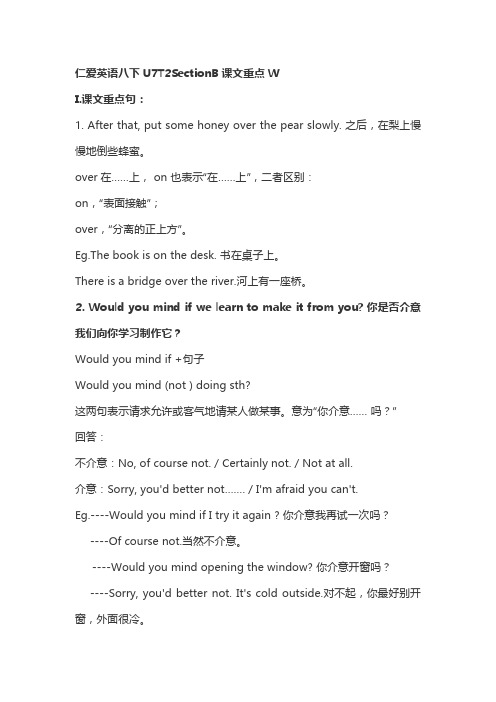
仁爱英语八下U7T2SectionB课文重点WI.课文重点句:1. After that, put some honey over the pear slowly. 之后,在梨上慢慢地倒些蜂蜜。
over在……上, on 也表示“在……上”,二者区别:on,“表面接触”;over,“分离的正上方”。
Eg.The book is on the desk. 书在桌子上。
There is a bridge over the river.河上有一座桥。
2. Would you mind if we learn to make it from you? 你是否介意我们向你学习制作它?Would you mind if +句子Would you mind (not ) doing sth?这两句表示请求允许或客气地请某人做某事。
意为“你介意……吗?”回答:不介意:No, of course not. / Certainly not. / Not at all.介意:Sorry, you'd better not……. / I'm afraid you can't.Eg.----Would you mind if I try it again ? 你介意我再试一次吗?----Of course not.当然不介意。
----Would you mind opening the window? 你介意开窗吗?----Sorry, you'd better not. It's cold outside.对不起,你最好别开窗,外面很冷。
3. Practice makes perfect. 熟能生巧。
(谚语)4. In Cuba, it’s impolite to eat so noisily. 在古巴,吃饭时发出的声音太大是不礼貌的。
1)impolite,不礼貌的。
polite ,“礼貌的”。
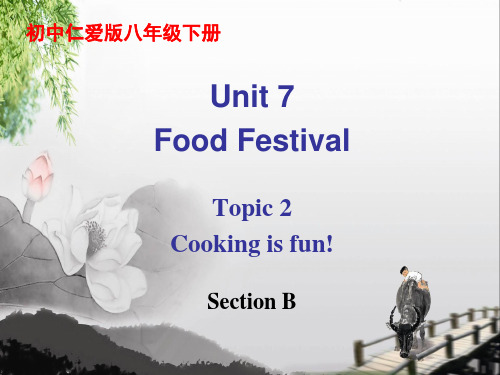
Unit 7 Food FestivalTopic 2 I’m not sure whether I can cook it wellSection B【学习目标】:1.谈论Kangkang和同学们为美食节做准备,学习西餐中三明治的做法。
复习运用表达请求和允许的功能用语,进一步学习运用表示顺序的副词的用法、以及由whether/ if引导的宾语从句。
2.初步接触单音节副词的比较级和最高级。
3.了解不同国家不同的餐桌礼仪,引导学生乐于接触和了解外国风俗文化,从而更好地为弘扬中国文化服务。
【学习重难点】:运用表达请求和允许的功能用语,进一步学习运用表示顺序的副词的用法、以及由whether/ if引导的宾语从句。
【学习过程】:第一段:短课导学模块一:自主学习学习内容摘记Step1. Leading & Listening1. Students retell the steps of cooking fried rice, using First… Second…Then… Finally…2. (PPT) First, learn the news : snack , butter, pear, pieceThen , T:Do you know how to make a sandwich with some bread and apear? Now,please watch the flash and finish 1b。
3. 播放视频,学生跟读。
Step2 品读----读出理解。
(自主学习:要求独立、安静完成)一、underline the following phrases and sentences1) 在1a 中,圈出这些表示顺序的副词:First…,Next…,Then…,After that…,Finally…;2) cut…into…把…切成…3) Would you mind if we learn to make it from you? 你介意我们跟你一起学做吗?4) Practice makes perfect. 孰能生巧嘛。
Unit 7 Topic 2 Section B一、教学目标. 词汇目标:学生能够掌握并熟练运用以下新单词:snack, butter, pear, piece, slurp, impolite, polite。
. 语法目标:•学生能够理解并正确运用单音节副词的比较级和最高级。
•学生能够掌握由if/whether引导的宾语从句的用法。
. 技能目标:学生能够按照步骤制作三明治,并能用英语准确描述制作过程。
. 发音目标:学生能够准确发音/ʃ/和/dʒ/这两个音标。
二、教学重难点重点:. 新单词的掌握与运用。
. 单音节副词的比较级和最高级的理解与应用。
. 由if/whether引导的宾语从句的掌握。
. 制作三明治并描述其过程。
难点:•制作三明治并用英语准确描述其过程。
三、教学用具•计算机多媒体投影仪•PPT课件•相关视频•面包、黄油、水果(如梨)、刀具、蜂蜜等制作三明治所需的材料四、教学过程1. 热身阶段(Warm-up)•分组:将学生分为“面包队”、“黄油队”、“蜂蜜队”和“梨队”。
•问候与猜测:教师与各队学生进行问候,并展示一个盒子,让学生猜测盒子里有什么(盒子里装有一些水果)。
•展示水果沙拉:教师展示事先准备好的水果沙拉,激发学生的兴趣。
2. 导入阶段(Lead-in)•情境导入:教师介绍一个喜欢零食的朋友Michael,并展示snack单词卡以及各种小吃图片。
询问学生Michael最喜欢的零食是什么,他是如何制作的。
然后播放音频,让学生听录音。
3. 呈现阶段(Presentation)•听力练习:播放1a的录音,让学生选择正确答案。
•新单词与短语学习:教授pear, butter, bread, a piece of, cut...into small pieces等新单词和短语。
•再次听力练习:再次播放录音,让学生完成1b的练习。
4. 练习与巩固阶段(Practice and Drills)•对话一:展示Kangkang与Michael的对话,让学生逐句跟读、复述,并根据关键词重新组织对话。
unit7 Topic2 sectionB教案设计Ⅰ. Material analysis本节课建议用1-2课时上完。
主要活动为Section B 的1a和2。
本课继续谈论Kangkang和同学们为美食节做准备,继在Section A中呈现炒饭的做法之后,本课又推出了西餐中三明治的做法。
要求学生复习运用请求允许的功能用语,在进一步学习运用表示顺序的副词的用法、以及由whether/ if引导的宾语从句之外,初步接触单音节副词的比较级和最高级,并要了解不同国家不同的餐桌礼仪。
通过让学生亲自动手做三明治,鼓励学生要勇于实践、大胆尝试,培养他们的自主探究精神;还要引导学生乐于接触和了解外国风俗文化,从而更好地为弘扬中国文化服务。
Ⅱ. Teaching aimsKnowledge aims:1. 学习whether/ if 引导的宾语从句。
2. 学习单音节副词的比较级和最高级。
3. 了解不同国家的餐桌礼仪。
4. 学生能区分辅音音素/ tʃ/和/ dʒ/, 并能正确拼读单词。
5. 学生能在朗读句子时正确处理语调和停顿。
Skill aims:1. 能听懂有关食物制作话题的对话,识别主题,并获取主要信息。
2. 能使用英语陈述食物的制作过程。
3. 能理解所给语言材料中事件的发生顺序和人物行为。
4. 能写出简单的文段。
Emotional aims:1. 在其原有的英语学习愿望和兴趣的基础之上,勇于实践、大胆尝试,培养自主探究精神。
2. 乐于接触和了解外国风俗文化,从而更好地为弘扬中国文化服务。
Ⅲ. The key points and difficult pointsKey points:1. 学习whether/ if 引导的宾语从句。
2. 学习单音节副词的比较级和最高级。
3. 了解不同国家的餐桌礼仪。
Difficult points:一边操作一边使用英语陈述食物的制作过程。
Ⅳ. Learning strategies1. 运用表示顺序的副词更加清楚地进行表述。
2. 运用表示顺序的副词对事情的过程进行描述时,注意语调的前升后降。
Ⅴ. Teaching aidsComputer multimedia projector; The pictures of sandwich and snack (hamburgers, sandwiches and so on); Some pieces of br ead; Some butter; A pear; A knife; Some honey; Thepictures of a bicycle, a bus and a train.Ⅵ. Teaching proceduresStep InteractionpatternStudent activity Teacher activityIntroduction (8 minutes)1. The wholeclass work.2. The wholeclass work.3. The wholeclass work.4. The wholeclass work.5. The wholeclass work.6. The wholeclass work.7. Pair work.8. The wholeclass work.9. The wholeclass work.10. The wholeclass work.11. The wholeclass work.1. Focus their attentionon the teacher.2. Students read thepassage about how tocook their favoritefood.3. Students retell the stepsof cooking fried rice,using First… Second…Then… Finally…4. Students read thesentences of 4b bythemselves, payingattention to theintonation and pause.5. Students listen andcheck their reading.6. Students listen and tryto imitate.7. Students practice theconversation of 4bwith their par tners.8. Students try readingthe phonetics andwords on the screen.9. Students listen to therecording of 4a.10. Students listen andtry to imitate.11. Students read thewords correctly.1. Greet students ready forlearning.2. Teacher lets the studentsread the passage abouthow to cook their favoritefood, using adverbs ofsequence and manner.3. Teacher asks the studentsto retell the steps of cookingfried rice, using Fi rst…Second… Then… Finally…4. Teacher asks the studentsto read the sentences of4b by themselves, payingattention to the intonationand pause.5. Teacher plays the recordingof 4b. Let students listenand check their reading.6. Teacher plays the recordingof 4b again, and let thestude ntslisten and try to imitate.7. T eacher lets students practicethe conversation of 4bwith their partners.8. Teacher shows the phonetics/tʃ/ and /dʒ/and thewords on the screen. Let thestudents try reading them.9. Teacher plays the recordingof 4a. Let students just listen.10. Teacher plays the recordingof 4a again, and lets thestudents listen and try toimitate.11. Teacher shows morewords on the screen. Askthe students to read themcorrectly.Presentation (10 minutes) 1. The wholeclass work.2. Individualwork.3. Individualwork.4. The wholeclass work.5. Individualwork.6. Individualwork.7. The wholeclass work.8. The wholeclass work.1. Students look at thepicture of 1a and havea guess.2. Students read 1a andcheck the guess.3. Students underline thenew words.4. Students learn and graspthe new words withthe help of the teacher.5. Students fill in theblanks of 1b.6. Students listen and checktheir answers.7. Students check theanswers.8. Students read 1a andfind out the difficultpoints. Then underlinethem with the teacher’shelp.1. The teacher lets studentslook at the picture of 1aand have a guess: What’sMichael’s favorite food?2. Teacher lets students read1a and check the guess.3. Teacher plays the recordingfor students and lets themunderline the new words.4. Teacher teaches the newwords to the students:Teach snack by showingthe picture of hamburgers,sandwiches, cookies andbiscuits.Teach butter and pear byshowing pictures of them.Teach piece by cutting thepear into pieces.5. Teacher plays the recordingsentence by sentence andlets the students fill in theblanks of 1b.6. Teacher plays the recordingwithout stopping. Let studentslisten and check theiranswers.7. Teacher asks two studentsto tell their answers.8. Teacher asks students to read1a and find out the difficultpoints, and then explain thekey points and the difficultpoints to the students.(1) W ould you mind if welearn to make it fromyou?(2) well→better →best(3) Practice makes perfect.Consolidation (10 minutes) 1. The wholeclass work.2. The wholeclass work.3. The wholeclass work.4. Pair work.5. The wholeclass work.1. Students read theconversation after therecording sentence bysentence.2. Students try to followthe speed, paying attentionto the pronunciationand intonation.3. Students read 1a againand prepare to makethe sandwich bythemselves.4. Students preformhow to make thesandwich.5. Students find out thesame structures in 1a.1. Teacher plays the recordingsentence by sentence.2. Teacher plays the recordingwithout stopping.3. Teacher asks the studentsto read 1a again and prepareto make the sandwich bythemselves, using the thingsthe teacher prepared.4. Teacher lets two or threepairs of students preformhow to make the sandwich.One student tells the processof making it, using First…Second… Then… Finally…And the other student makesit as what his or her partnerdescribes.5. Teacher evaluates thesandwiches which thestudents did by themselvesand encourages them withthe following structures:Well down! A did quitewell, but B did better thanA. C did the best of all.Then let students find outthe same structures in 1a.Stress the usage ofcom parative and superlativedegrees of monosyllabicadverbs.Practice (10 minutes) 1. The wholeclass work.2. Individualwork.3. The wholeclass work.4. Individualwork.5. The wholeclass work.6. The wholeclass work.7. Individualwork.8. The wholeclass work.9. Pair work.1. Students look at thepictures of 2 carefully,and read the parts of thesentences.2. Students match the partsof the sentences.3. Students read the sentencesand grasp the usage ofcomparative and superlativedegrees of monosyllabicadverbs.4. Students make upsentences.5. Students evaluate thework on the blackboard.6. Students read thesentences of 3. Learn thenew words.7. Students listen andnumber the sentences toform a conversation.8. Students check theanswers.9. Students practice theconversation in pairs.1. Teacher asks the students tolook at the pictures of 2carefully and read the partsof the sentences.2. Teacher lets students matchthe parts of the sentences.3. Teacher lets two studentstell the answer, and then askthem to read the sentences andgrasp the usage of comparativeand superlative degrees ofmonosyllabic adverbs.4. T eacher shows the pictures ofa bike, a bus, and a train. Askstudents to make up sentences.Ask two students to writethem down on the blackboard.5. Teacher lets two studentsevaluate the work on theblackboard.6. Teacher asks students to readthe sentences of 3. T each thenew words slurp by imitatingthe sound of drinking soup.Teach noisily by comparingwith noisy. Teach polite andimpolite by perform actionsof throwing out paper andpicking up the paper.7. Teacher plays the recordingof 3 for the students. Let themlisten and number the sentencesto form a conversation.8. Teacher lets two studentstell the answers.9. Teacher lets students practicethe conversation in pairs.Let them try imitating thenoise made by Kumikowhen she is drinking soup.Teaching ReflectionThe students are very glad that they can make the sandwich by themselves. They grasp the usage of object clauses well and learn the usage of comparative and superlative degrees of monosyllabic adverbs. And they are very interested in the tab le manners in different countries.Ⅶ. Blackboard designUnit 7 Food FestivalTopic 2 I’m not sure whether I can cook it well.Section B1. W ould you mind if we learn to make it from you?2. well→better →best3. Practice makes perfect.early →earlier →earliestlong →longer→longestPolite Impolite。